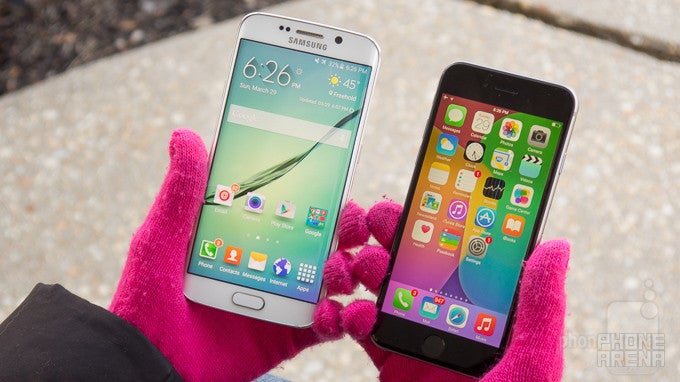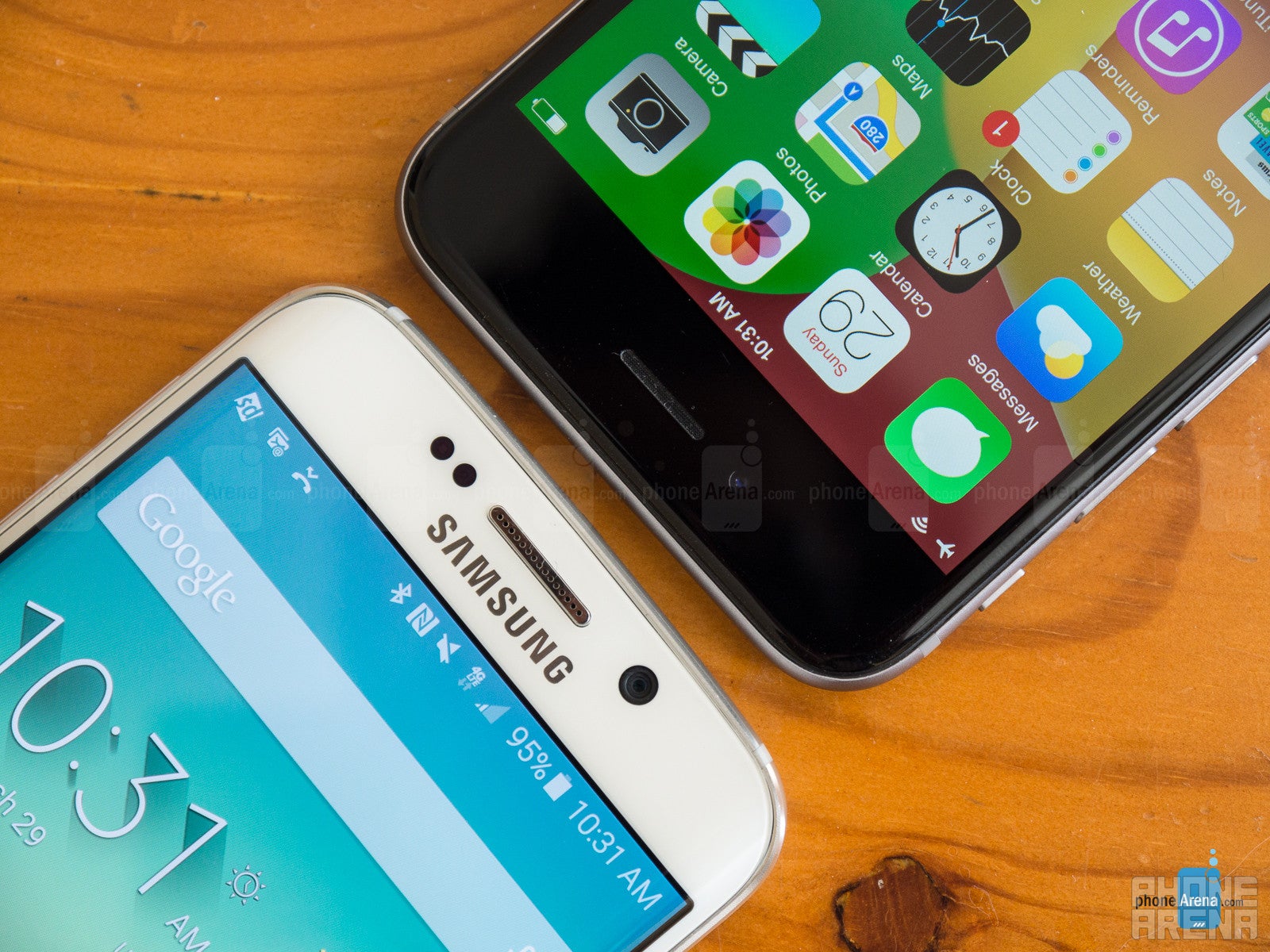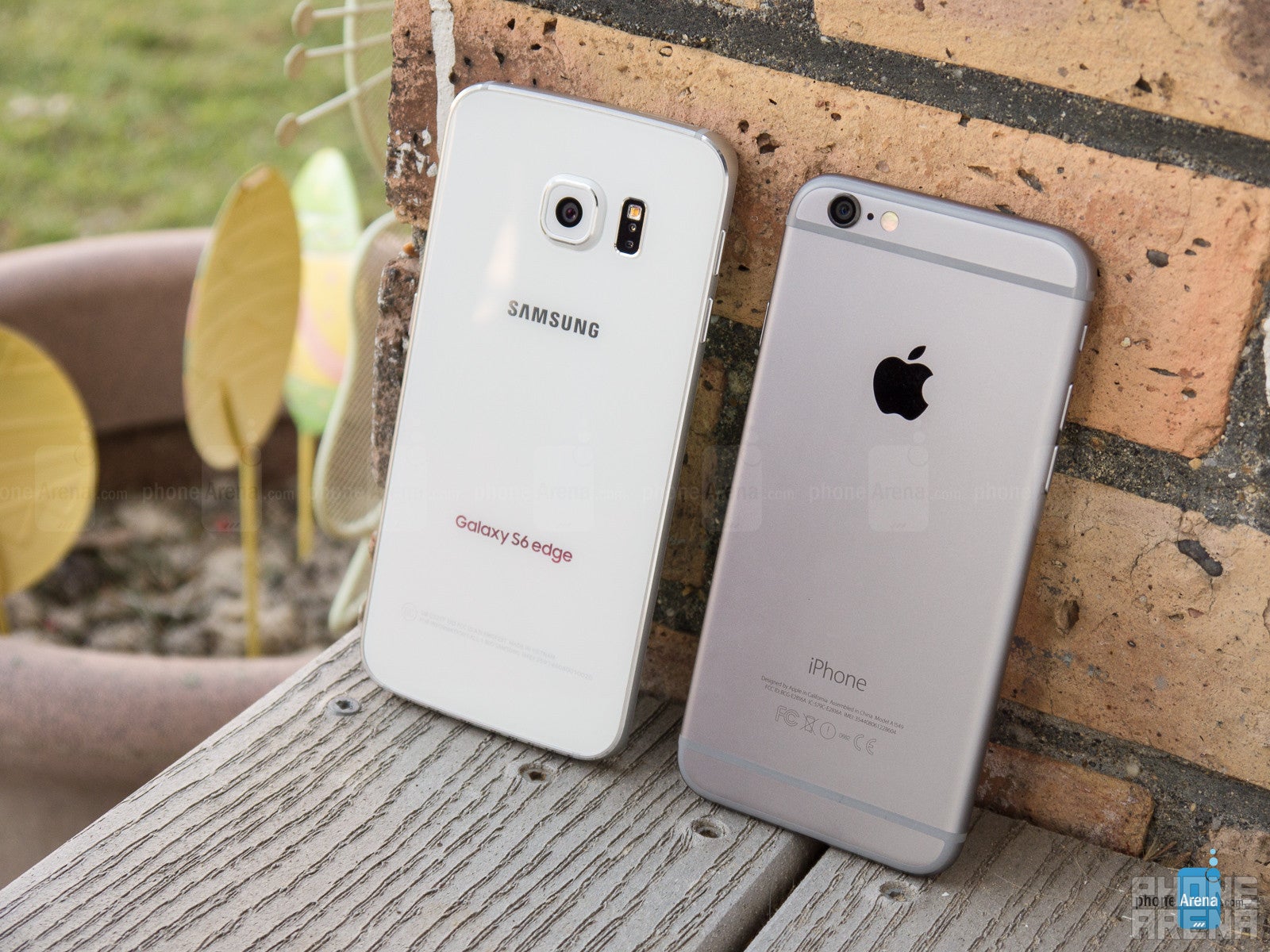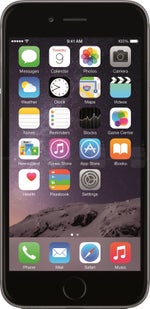Samsung Galaxy S6 edge vs Apple iPhone 6

Introduction
The Samsung Galaxy S6 edge might have sounded like a sci-fi gadget a few years ago with its flexible screen that curves towards both sides, but fast forward to today and this futuristic gadget has become a reality: in 2015, the S6 edge will be battling for attention on store shelves with more traditionally shaped devices. Its biggest rival? The Apple iPhone 6.
While there are two edges that make the phone look cool, you get to pick to use only one - either the left or the right one - for quick access to contacts and notifications. For all else, the Galaxy S6 edge is identical to its S6 sibling.
How does it compare to the iPhone 6, though? Both are stylish devices - the iPhone is made from metal, while the S6 edge features glass on the front and back, and metal for the frame. In order to decide which one to buy, we look at their performance, camera capabilities, battery life and more. And yes, we do explore how TouchWiz has changed and whether the change is for the better.
Read on as we explore the Galaxy S6 edge, iPhone 6 and all their secrets to try and give you an answer to the big question: which one should you buy.
Design
Samsung has stepped up to have a truly stylish and futuristic device with the S6 edge, almost on par with the all-aluminum iPhone 6. Both are impressively thin phones.
After years of uninspiring plastic designs, Samsung has finally listened in: the new Galaxy S6 edge is made of fine-quality materials and has a truly premium feel. The S6 edge features a sturdy metal frame sandwiched between two pieces of glass on the front and back. Samsung has also added new color options: the S6 edge is available in a choice of black, white, gold, and green. The Apple iPhone 6, on the other hand, features an all-aluminum build with a choice of space grey, silver, and gold.
Both the Galaxy S6 edge and iPhone 6 are impressively thin devices: the iPhone 6 is a hair thinner at 6.9mm, while the Galaxy S6 edge measures 7mm in thickness. The difference is barely noticeable, but what is noticeable is that both phones have a protruding camera module resulting in a hump on the back of both devices (a significantly larger one on the Galaxy S6 edge).
The two phones are fairly lightweight: 4.66oz for the S6 edge and 4.55oz for the iPhone 6. Given the larger screen in the Galaxy S6 edge, it’s also no surprise that the Samsung phone is also larger: 5.59” tall and 2.76” wide, while the iPhone 6 is a more manageable 5.44” tall and 2.64” wide. However, saying that the S6 edge is larger would not give Samsung credit where credit is due, and that is that the S6 edge is one of the most compact and single-hand-friendly phones for its 5.1” screen size.
Buttons are clicky, large enough and have a reassuring tactile feedback on both phones, and the positioning of the keys is identical: the lock key is on the right and the volume buttons - on the left.
We’re also happy to see a fingerprint sensor built in the home button on both phones: the Galaxy S6 edge is the first phone from Samsung to use a new tap (rather than swipe) based fingerprint reader, and it works quickly and accurately, just as the one on the iPhone 6. While you are limited to using the fingerprint scanner on the iPhone for Apple Pay, unlocking the phone and authorizing App Store purchases, though, the fingerprint functionality on the Galaxy S6 edge is not limited to that and you can use it to protect particular apps and functionalities (via third party apps).
Display
The edges are a nice cool feature, but it’s more about the cool factor rather than any huge actual benefits. For all else, the Galaxy S6 edge has a remarkably well calibrated 5.1” Super AMOLED Quad HD display, taking it a step ahead of the already great iPhone 6 LCD screen.
The Samsung Galaxy S6 edge features a 5.1-inch Super AMOLED display, larger than the 4.7” IPS LCD screen of the iPhone 6. With a resolution of 1440 x 2560 pixels (Quad HD), the screen on the Galaxy S6 edge is extremely crisp and paper-like with a pixel density of the record 577ppi. The iPhone 6, on the other hand, features a more modest resolution of 750 x 1334 pixels, which works out to a pixel density of 326ppi. The difference in the numbers is staggering, but the actually perceptible difference in sharpness is not that big at all: you’d notice a slight pixelization on the iPhone if you stare from very up close, while from regular distances the difference is minimal.
The big story for the S6 edge is clearly the curved rims on both sides of the display. The added functionality boils down to three main features: People Edge (where you get quick access to your favorite contacts), Edge Lighting (where the edge lights up when you get incoming calls, messages, or other notifications), and Information Stream (which brings you news/events ticker functionality). Also, the edges just plain look cool.
For all else, we will look at the S6 edge as a regular display. With sharpness now reaching a level where it’s hard to notice pixelization on all major flagships, the last remaining frontier to conquer in the way towards the ideal display seems to be image quality. Good news is that the Galaxy S6 edge and the iPhone 6 feature two of the best smartphone displays out there.
In the S6 edge you get to those nice colors in ‘Basic’ screen mode (go into Settings > Display > Screen mode, and select Basic), while other modes serve unnatural, overblown colors. Colors in Basic mode stick to the industry-standard sRGB color space with impressive accuracy: color temperature at 6800K means that you get natural-looking whites (with just a slight bit of a cold tint), and gamma at 2.2 is right where it should be, meaning that image brightness is accurate. Impressively, color saturations are practically perfectly seated in their reference values, resulting in great color calibration. The iPhone 6, on its part, also has a very good LCD display when it comes to colors, but it’s a step below the nearly perfect calibration of the Galaxy S6: whites are a bit colder, while color errors are minimal, but still higher than on the S6.
Samsung has made some notable progress with maximizing brightness on AMOLED displays. The Galaxy S6 edge, in particular, comes with Samsung’s most luminant AMOLED reaching 553 nits at maximum levels. Brightness on the S6 edge is still a step below what the iPhone 6’s LCD display, though, as that can put out with 606 nits of peak luminance.
Interface and Functionality
TouchWiz without the fat! The impossible has happened: the Galaxy S6 edge runs fairly smoothly, and adds a few tricks up its sleeve, competing with the iPhone 6's iOS 8.
Let’s get right to the big question: has TouchWiz changed for the better in the Galaxy S6 edge? While a lot has stayed the same, we’re happy to say that change has arrived in places that matter, and while we still have some gripes, we have encountered almost no stutter in TouchWiz, while it’s gotten redesigned towards simplicity, with a modern, clutter-free style.
Under the TouchWiz hood, the S6 edge is powered by Android 5.0 Lollipop with all the performance improvements of the latest version of Google’s operating system. The iPhone 6, on the other hand, features iOS 8, a familiar platform that changes slowly, sticking to a proven formula of simplicity and lack of elaborate customizations.
At first look, one thing has remained unchanged in TouchWiz: the cartoonish stock Samsung icons that many hoped to see redrawn. A closer look, however, reveals that the built-in apps have all gotten a Lollipop-inspired style with material design inspiration. The menu - a traditionally puzzling endless list of options - has also been simplified. We’re also happy to see the option to add a quick-access toggle for a flashlight in the notification shade. The signature multi-window feature of TouchWiz has now moved as well, and is found built in the multitasking cards.
The TouchWiz themes that we first saw in the Samsung Galaxy A series are now more and you have a store where you can download even more of them (we’re sure hundreds of themes from developers will soon flood this space). Selecting a new theme changes not only the wallpaper and icon style, but even some built-in apps, widgets, sounds and font style, and that’s the main difference between a theme and a custom Android launcher.
The new double click on the home button gesture to start the camera is an awesome new addition to TouchWiz (previously, double clicking used to bring up S Voice). It’s also interesting to see Samsung throw a gauntlet at Google and include a separate folder with pre-installed core Microsoft Office apps on the Google Android-powered S6.
iOS 8, on the other hand, differs vastly from Android, if just for the fact that it does not have a dedicated app drawer, nor the rich customization options that Google’s platform offers. On the flipside of things, the iOS ecosystem of apps seems to be richer, and the platform is more fit for gamers, as the latest releases arrive sooner and often exclusively to iOS.
Basic functionality, things like telephony and texting, are well covered on both phones with a rich contacts and phone app, and a straightforward messaging app. iOS 8 has also added support for third-party keyboards, so you can have popular keyboards like SwiftKey and Swype, which is nice. The stock keyboards, however, both do an excellent job with well spaced out keys and a quick, adequate tactile response to your taps.
Processor and Memory
Samsung ditches Snapdragon chips for its 14nm Exynos 7420 octa-core chip, and it performs admirably. The iPhone 6 is perfectly on par, and even outdoes it in gaming and single-core tests.
Samsung has ditched Qualcomm’s Snapdragon chips for its own Exynos 7420 octa-core chip on the Galaxy S6 edge, and that’s a good thing: this is the first 14nm chip we see on a smartphone, and - with some optimizations on the TouchWiz side of things - we see very smooth and pleasing performance. The Apple iPhone 6 has been there from the beginning: it features a traditionally smooth performance from the very first editions, and the iPhone 6 is no exception to that rule with its Apple A8 chip.
Looking at the tech specs, the Exynos 7420 on the S6 edge comes equipped with four Cortex-A57 high-performance cores running at up to 2.1GHz and four power-savvy Cortex-A53 cores clocked at up to 1.5GHz, all connected in a big.LITTLE setup. The Galaxy S6 edge also has a Mali-T760 GPU and sports 3 gigs of RAM. The iPhone 6, on its part, features the dual-core Apple A8, but comparing just core counts is a tricky affair, and one should keep in mind that the Cyclone CPU cores in the A8 are larger and much more powerful, so it’s no surprise to see that the crucial single-core performance is still higher in the iPhone 6. Regardless, Apple has taken some criticism for including just 1GB of RAM on the iPhone 6, which forces apps to reboot more often, making multitasking theoretically a bit faster on the S6 edge.
For gaming benchmarks, the Galaxy S6 edge does well, but its Quad HD resolution brings its benchmark results down, and the iPhone 6 wins this round with its blazing-fast framerates.
The Samsung Galaxy S6 edge comes equipped with 32GB of internal storage in the base model, which is a great advantage over the 16GB of internal storage available on the comparable iPhone 6 base model. The next tier moves to 64GB for both the Galaxy S6 edge and iPhone 6, where we have parity.
It’s notable that after five years of having expandable storage on Samsung’s Galaxy S series, the S6 edge does away with the microSD expansion card slot. The new Galaxy S6 edge does not feature expandable storage, just like the iPhone, so you’d have to clean up contents more often or rely on the cloud to store your data.
Internet and Connectivity
Surfing the web is fast and stutter-free, and both phones support a plethora of 4G LTE bands.
The Galaxy S6 edge ships with two browsers on board: Samsung’s own solution packed with various features that offers neat options like a full-screen view, and the mobile version of Google Chrome. The iPhone 6, on the other hand, sports mobile Safari, which is a nimble browser that comes with support for the very comfy iOS touch gestures for navigation - something that Android phones do not have.
Surfing the web is a fast and smooth experience on both devices: it’s hard to notice any slowdowns when scrolling around a page, or zooming in and out.
Samsung brings a vast amount of 4G LTE bands that ensure the Galaxy S6 edge will run on most carriers’ LTE networks. The iPhone 6 is also a record-holder as it sports between 16 and 20 different LTE bands (models vary slightly). Other standard connectivity options on both include: dual-channel Wi-Fi, aGPS with Glonass, Bluetooth 4.1, and NFC.
The Galaxy S6 edge also comes with support for MHL 3.0, a standard that makes it possible to stream 4K videos to a TV, while the preceding S5, for instance, only supported MHL 2.0 and 1080p streaming.
Then, the S6 edge also has the advantage of having an infra red (IR) beamer and a dedicated Peel Smart Remote app that allows consumers to use the phone as a TV/AC remote, which is nice. The app also doubles as a TV guide, while for the iPhone 6 such features are lacking.
Camera
The 16-megapixel OIS camera on the Galaxy S6 edge is a great shooter, especially for video with 4K and for daylight stills, but in low-light conditions it is a step behind the iPhone 6.
The Samsung Galaxy S6 edge sports a 16-megapixel rear camera with optical image stabilization (OIS) and a 5-megapixel selfie cam up front, while the Apple iPhone 6 comes with an 8-megapixel main camera that lacks OIS and a 1.2-megapixel selfie shooter.
Both cameras protrude slightly (more so on the S6 edge) because of the larger-than-typical size of the camera module, as well as the very thin size of the phones. The S6 edge main camera features the 1/2.6” Sony IMX240 sensor. The iPhone 6, in comparison, features a smaller, 1/3" sensor but opts for a more conservative 8-megapixel resolution, which results in larger, 1.5micron pixels that theoretically provide an advantage for low-light shooting.
Samsung’s new double-click shortcut to start the camera works admirably well. The iPhone 6’s camera app is also quick to start but not as fast as the one on the S6 edge. Samsung has also cut unnecessary complication off the camera interface leaving the essential options clearly visible, and that’s a good thing. On the other hand, the iPhone 6’s camera app is traditionally simplistic and user-friendly. You can tap to focus on parts of the image, and also hold your finger and swipe up and down to manually tweak exposure, but pretty much all other manual controls - including shutter speed - are available via third party apps like ProCamera 8.
That’s all good, but what about image quality? Right out of the box it’s clear that the Galaxy S6 edge captures great-looking images with especially strong performance in bright sunlight where detail is aplenty and colors are reproduced in a natural, pleasing way. In similar conditions, the iPhone 6 also captures good detail, with colors on it that seem a bit overblown and not all that natural, but also very impressive because of that added boost.
Turning over to low light conditions, noise and color inaccuracies start to creep into the images from both devices. It's often a hit-or-miss affair, with the Galaxy S6 edge faring better in some scenes, and the iPhone 6 coming out on top in other. The Galaxy S6 still dominates in the details department, though blurriness in some photos causes it to sometimes lose to its adversary in that very department. The single LED flash on the S6 edge does a good job lighting up the central part of an image, but it does introduce a slight unnatural cold tonality, while the iPhone 6’s dual LED flash is a bit harsher in its power, but does not distort colors in an image.
The front camera is one area where the Galaxy S6 edge steps up its game and is a leap ahead of the iPhone 6: selfies on it turn out very good, with a lot of detail, and it’s neat that you can tap on the heart rate sensor with a finger as a quick shortcut for selfies. The iPhone 6, in return, features very low-res images that don’t look nearly as good.
In terms of video, we are genuinely impressed with the quality of recordings on the S6 edge: 4K video capture features rich color and outstanding details, while optical image stabilization makes sure that recordings are not shaky. We’re also smitten with the super-quick auto-focusing speeds of the S6 edge and its capability to track focus as an expensive camcorder. It also has the option to record in 1080p at 60 fps for lovers of those motion-blur-free high frame rates. The iPhone 6, on the other hand, lacks a 4K option, and while video on it also looks very good with super fast auto-focusing - it does not have optical stabilization and recordings can turn out annoyingly shaky.
Multimedia
Material designed-inspired Galaxy S6 edge media apps improve the video and music experience, while the iPhone comes with the huge iTunes ecosystem to its advantage.
The new TouchWiz on the Galaxy S6 edge introduces a material design cues to stock apps. The newly updated music and video player apps in particular feature a minimalist, flat and airy style, and they are color-coded for easy differentiation. The functionality has not changed much at that: music is sorted by genre, artist, album, and so on, and you can manually select music from folders, which is nice. The iPhone 6, in return, has an equally straightforward app, but file synchronization is handled exclusively via iTunes and it is impossible to simply drag and drop your MP3 collection onto it.
The image gallery on the S6 edge is now also cleaner with a modern flare: it’s much cleaner, with a white backdrop, and a zoomable timeline with the capability to quickly scroll through images in time. Image editing options are built right in the gallery app, so that you can control brightness, contrast, saturation, temperature, and the hue of an image. The private mode that allows you to hide sensitive images is a welcome feature. The iPhone 6 gallery on its part is also a clean and simple app that offers similar neat image editing options with an even more intuitive controls, but it lacks the flare of things like private mode.
Both phones come with a single loudspeaker located on the bottom of the phone. The Galaxy S6 edge speaker goes up to the fairly loud to 73.7dB, and the iPhone 6 is even louder, pumping out tunes at up to 74.5dB. Quality on both is above average, but they lack the depth and richness we’ve seen in, say, the HTC One series.
Call Quality

The iPhone 6, in return, is a bit on the quiet side in calls, but call quality is cleaner, with much less distortion.
Turning to the speakerphone, the Galaxy S6 edge has enough power to make it comfortable to use in noisy environments, and on the other end of the line sound is fairly clear, while the iPhone 6 does have a slightly more noticeable distortion when using it via speakerphone.
Battery
The Galaxy S6 edge offers a bigger battery than the iPhone 6, and it sports a seriously impressive quick charging option.
The Samsung Galaxy S6 edge features a 2600mAh battery, while the iPhone 6 sports a more modest, 1810mAh battery pack.

The other huge new breakthrough in the battery department for the Samsung Galaxy S6 edge is in its lightning-fast recharge times. The Galaxy S6 edge is among the fastest charging phones we’ve seen so far: it takes just an hour and 23 minutes to recharge from 0 to 100, while the iPhone 6 - despite its much smaller battery - takes nearly double that time: 2 hours and 27 minutes.
While you won't find any dedicated battery-saving modes on the Apple iPhone 6, the Galaxy S6 features the useful Ultra Power Saving Mode, where you can still use essential apps like calls and messages, as well as Facebook and your browser, but everything turns black and white, processor speed is capped, and battery life is thus boosted to a whole day with less than 10% of juice left.
Conclusion
Samsung’s futuristic Galaxy S6 edge looks plain cool, and with the choice of premium quality materials such as glass and metal, we can finally say that Samsung’s flagship has some serious aspirations in style. This puts it in a place where the iPhone 6 has long been.
What’s better, though, is that the changes and improvements in the S6 edge are far from superficial: the phone is very fast, has an industry-leading camera and a cutting-edge display, and is packed with useful features (as well as some not so useful ones).
The edge alone is a cool addition that adds some neat functionality, but it’s hard to see it as a huge advantage - it’s just a cool little innovation at the moment. If you want an Android phone that adds that cool factor with overall very solid performance, the S6 edge is the one to get. The iPhone 6 still has the advantage of more apps and games, as well as the perfected iOS 8 experience. For most other things, there is parity – you really can't go wrong with either of the two phones.

Samsung Galaxy S6 edge
Pros
- Great AMOLED screen with various color modes and record sharpness
- Super-fast-to-launch camera, 4K video recording
- Useful Ultra Power Saving ModeQuick charging capability, wireless charging support
Apple iPhone 6
Pros
- Slim and elegant metal design
- iOS 8 works stutter-free, features the latest and hottest apps and games
- Super intuitive user interface
- Apple Pay is the first mass-scale mobile payment system already working in the US





























Things that are NOT allowed: